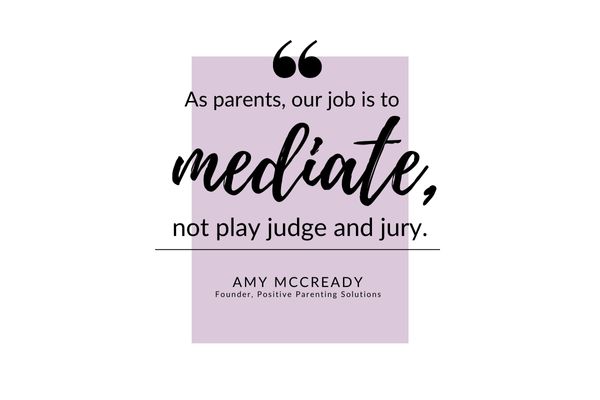

It’s 7 AM, and you’re sitting in absolute silence, enjoying a steaming hot cup of coffee before diving into the usual morning madness.
You let out a deep sigh of enjoyment. These are the mornings you live for. Nothing but perfect peace until you hear…
SLAM!
“Mom!”
“Dad!”
“He won’t leave me alone!”
“She’s not letting me use the bathroom!”
“I was here first!”
Ah, yes, the morning routine has begun. And once again, your kids are at each other’s throats.
That hot coffee and silence were nice while they lasted, you think. But now the real day begins.
Sound familiar?
Let’s face it – sibling spats are a part of life.
In fact, sibling rivalry is not only inevitable; it’s a healthy way for kids to learn how to compromise and navigate relationships.
But on the downside, the constant bickering can also wreak havoc on daily life, not to mention Mom’s and Dad’s nerves.
Our goal is to achieve at least some measure of sibling harmony, right?
Right! In fact, this idea of “sibling harmony” is so desired among parents that we’ve dedicated an entire masterclass to the topic as part of our Household Harmony Trifecta Series.
Enroll in the Sibling Harmony Masterclass today and put an end to those frustrating battles tomorrow!
All parents want their kids to get along. But few feel confident in their ability to bring that harmony home.
But I can promise you, sibling harmony is possible!
It may sound like an impossible dream, but it’s absolutely do-able with these 5 Tips for Sibling Harmony:
Tip #1: Don’t Compare or Label Your Kids
One of the easiest mistakes for parents to make is labeling and comparing our kids. I get it!
Perhaps you’ve found yourself saying something like, “He’s my shy little guy,” or “She’s always been the studious one in the family.”
Sounds innocent enough, but even subtle labels fuel sibling rivalry. It can also unintentionally lead to a feeling of competition between them.
Think about it from their perspective…
If Mom refers to my sibling as the “studious one” by default, I assume that I’m not particularly studious. If she affectionately refers to me as “her wild one” or “her handful,” most likely, my sibling will feel rather superior as the “well-behaved” one.
Knowing how you may unintentionally label your kids and fuel competition is a great first step in banishing the bickering in your house.
Tip #2: Spend One-on-One Time Daily with Each Child
The most important strategy to minimize sibling rivalry is to deliberate about daily one-on-one time with each child and build connections. We like to refer to this time as MIND, BODY AND SOUL TIME® togetherness.
That’s simply ten to fifteen minutes per day when your child has YOU to herself. This short time will go a long way toward reducing sibling competition for your attention.
It’s no secret that well-behaved kids are often ignored, while misbehaving kids get attention.
Beat them to the punch by proactively filling their attention baskets, and you’ll find that their attention-seeing behaviors, such as squabbling, will decrease.
Tip #3: Be a Mediator, Not a Referee
At this point in parenthood, you may feel as though you should always carry a whistle and invest in a fully-stocked wardrobe of black-and-white striped shirts.
While you may feel like a referee, that is not your job! In fact, when parents referee sibling scuffles and choose sides, rivalry naturally escalates.
As parents, our job is to mediate, not play judge and jury. Bring the parties together and help them devise a solution they can feel good about. That way, there are no winners or losers, and they’ll learn valuable skills they’ll use in future conflicts.
Yes, sometimes we really can all win.
Tip #4: Don’t Force Kids to Share
Learning to share is important, and so are boundaries.
When kids are forced to turn something over to a sibling (especially when it’s a new gift), it sends them a very clear message: Sharing feels bad, and I don’t want to do it again.
Instead of forcing your child to “give your sister a turn,” you can say, “That’s Megan’s new toy, and she’ll let you have a turn when she’s ready.”
This creates a feeling of safety for Megan. Over time, she’ll feel less territorial and be willing to share on her own.
Helpful Hint: Heather Schumacher offers great advice on this topic, including the words to say, in her book, It’s OK Not to Share and Other Renegade Rules for Raising Competent and Compassionate Kids.
Tip #5: Tolerate the Tantrums
Kids continue behaviors that work for them.
When parents give in to a sibling’s tantrum and say, “Oh, just give her a turn!” it fuels sibling rivalry and reinforces that the best tactic to get what you want is to pitch a fit.
Make sure the tantrum “doesn’t work” by letting it run its course. (I know it’s hard!)
In the midst of the tantrum, you can empathize with your child. This may sound something like…
“It’s hard to wait, isn’t it? Would you like to play with something else now?”
While letting the tantrum run its course may feel particularly painful while it’s happening, over time, you’ll see your persistence and refusal to give in pay dividends on how your kids behave together.
Final Thoughts
Imagine a household where sibling rivalry and fights are a rare occurrence.
It may seem like a pipe dream, but I promise it isn’t!
If you stay armed with these 5 tips and you’ll not only help your kids navigate sibling relationships–they may even achieve sibling harmony!
If, after testing the waters with these 5 tips, you still need more sibling rivalry solutions — don’t worry. Enroll in our Sibling Rivalry Solutions Masterclass and put an end to these exhausting power struggles.
Here’s wishing you and your children the best, most harmonious household ever!



















